|
|

Product Numbers: PA-2JT2 and PA-2JT2=
This configuration note describes how to install and configure the Japan T2 Line (JT2) 6.3-megahertz (MHz), 2-port, serial port adapter (PA-2JT2[=]), which is used on the second-generation Versatile Interface Processor (VIP2) in all Cisco 7500 series and in Cisco 7000 series routers using the 7000 Series Route Switch Processor (RSP7000) and 7000 Series Chassis Interface (RSP7000CI). (For complete and specific compatibility requirements, refer to the section "Software and Hardware Prerequisites" on page 3.)
This configuration note is organized into two parts:
2. The following section includes information specific to the JT2 port adapter's use with the VIP2 in Cisco 7000 series and Cisco 7500 series routers—VIP2 and the JT2 Port Adapter
The section "Cisco Connection Online," on page 27, includes general reference information.
The Cisco Internetwork Operating System (Cisco IOS) software running your router contains extensive features and functionality. The effective use of many of these features is easier if you have more information at hand. For additional information on configuring and maintaining the Cisco 7000 series, Cisco 7200 series, and Cisco 7500 series routers, the following documentation resources are available:
For JT2 port adapters installed on the VIP2-40 in Cisco 7000 series or Cisco 7500 series routers, Cisco IOS Release 11.1(12)CA1, or later, is required.
For JT2 port adapters installed on the VIP2-50 in Cisco 7000 series or Cisco 7500 series routers, Cisco IOS Release 11.1(14)CA, or later, is required.
 | Caution The VIP2 will not operate properly with the Route Processor (RP), Switch Processor (SP), or Silicon Switch Processor (SSP) installed in the earlier host Cisco 7000 series routers. |
The equipment described in this publication generates and might radiate radio-frequency energy. If it is not installed in accordance with Cisco's installation instructions, it might cause interference with radio and television reception. This equipment has been tested and found to comply with the limits for a Class B digital device in accordance with the specifications in part 15 of the FCC rules. These specifications are designed to provide reasonable protection against such interference in a residential installation. However, there is no guarantee that interference will not occur in a particular installation.
You can determine whether your equipment is causing interference by turning it off. If the interference stops, it was probably caused by the Cisco equipment or one of its peripheral devices. If the equipment causes interference to radio or television reception, try to correct the interference by using one or more of the following measures:
This section provides safety guidelines you should follow when working with any equipment that connects to electrical power or telephone wiring.
Safety warnings appear throughout this publication in procedures that, if performed incorrectly, might harm you. A warning symbol precedes each warning statement.
Follow these basic guidelines when working with any electrical equipment:
Electrostatic discharge (ESD) damage, which can occur when electronic cards or components are improperly handled, results in complete or intermittent failures. Port adapters and processor modules consist of printed circuit boards that are fixed in metal carriers. Electromagnetic interference (EMI) shielding and connectors are integral components of the carrier. Although the metal carrier helps to protect the board from ESD, use a preventive antistatic strap during handling.
Following are guidelines for preventing ESD damage:
 | Caution For safety, periodically check the resistance value of the antistatic strap. The measurement should be between 1 and 10 megohms. |
PA-2JT2 (see Figure 1) is a port adapter used on the VIP2 in the Cisco 7500 series routers, and in Cisco 7000 series routers using the RSP7000 and RSP7000CI. The JT2 port adapter is available as a spare part: Product Number PA-2JT2=.

Following are JT2 port adapter features and capabilities:
Figure 2 shows a VIP2 with two installed port adapters. Figure 3 shows a VIP2-50 with two installed port adapters. With the VIP2 oriented as shown, the left port adapter is in port adapter slot 0, and the right port adapter is in port adapter slot 1.
Port adapters have handles that allow for easy installation and removal; however, they are occasionally not shown in this publication to highlight port adapter faceplate detail.
In the Cisco 7000, Cisco 7507, and Cisco 7513 chassis the VIP2 is installed vertically. In the Cisco 7010 and Cisco 7505 chassis the VIP2 is installed horizontally. There are no interface processor or port adapter slot restrictions for the VIP2 and JT2 port adapter.


The JT2 port adapter (see Figure 4) contains the enabled LED, which is standard on all port adapters; this green LED goes on after system initialization to indicate that the JT2 port adapter has been enabled for operation.

The following conditions must be met before the enabled LED goes on:
If any of these conditions is not met, or if the initialization fails for other reasons, the enabled LED does not go on. The JT2 port adapter has three additional status LEDs for each JT2 port, which are labeled and function as follows:
The interface connectors on the JT2 port adapter are coaxial BNC types, with one connector/cable for transmit (TX) and one for receive (RX) for each interface port. Each BNC connection requires an external B-type or C-type DSU (with external grounding capability), with an optical fiber output, and that uses 75-ohm BNC terminations. (Cisco Systems does not supply 75-ohm coaxial cables; they are available from commercial cable vendors.)
 | Caution Your coaxial cable's loss must be less than 6 dB when using maximum cable lengths. To prevent problems, you must check your 75-ohm coaxial cable's specifications when long cable lengths are required to connect the JT2 port adapter to your DSU. Unbalanced JT2 interfaces allow for a longer maximum cable length than those specified for balanced circuits. Ideally, the maximum cable length for unbalanced, 75-ohm coaxial cable is 1,968.5 feet (600 meters). |
You must install a ferrite sleeve (also called a common-mode choke) on each 75-ohm coaxial cable to reduce the effects of electro-magnetic interference (EMI). (Cisco Systems supplies four ferrite sleeves with your JT2 port adapter; one ferrite sleeve for each of four 75-ohm coaxial cables you can attach to PA-2JT2.)
 | Caution The ferrite sleeve is a required component for proper system operation. |

Figure 6 shows the typical 75-ohm coaxial cable you should use with PA-2JT2. Use only this type cable for all PA-2JT2 connections. Use one 75-ohm coaxial cable for each PA-2JT2 connection: RX0, TX0, RX1, and TX1.

The pinout and signal descriptions for the BNC connectors on the JT2 port adapter are as follows:
Japan T2 (JT2) is a 6.312 kilobits-per-second (kbps) line format specified in ITU Recommendation G.704, and described in the Japanese NTT document Technical Reference for High-Speed Digital Leased Circuit Services.
A frame consists of 789 bits, and the frame repetition rate is 8 KHz, for a frame duration of 125 microseconds. There are four frames in a multiframe. In each frame, there are 98, 8-bit time slots (bit 1 through bit 784), starting with bit 1 in time slot 1 (TS1).
The last five bits of the frame, bit 785 through bit 789, are called the F-bits. The F-bits contain the frame and multiframe alignment signal, which consists of nine bits (110010100) carried in the first two frames of the multiframe.
This section describes the JT2 port adapter and its use with the VIP2.
The following sections provide additional information specific to the JT2 port adapter and its use on the VIP2 in Cisco 7000 series and Cisco 7500 series routers:
Figure 7 shows a VIP2-40 with two JT2 port adapters in port adapter slots 0 and 1. Port adapters can be installed in either (or both) port adapter slot 0 or port adapter slot 1. You can install VIP2s in any interface processor slots in your Cisco 7500 series or Cisco 7000 series router.
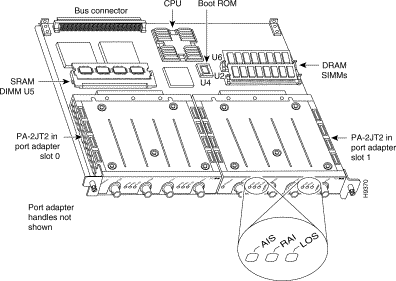
Figure 8 shows a VIP2-50 with two JT2 port adapters installed in port adapter slots 0 and 1.
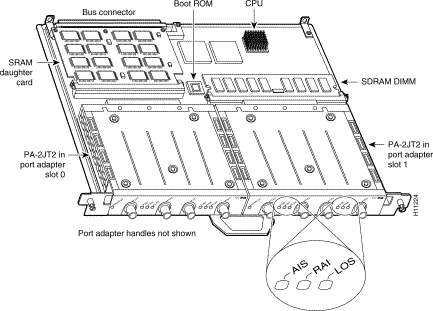
This section provides the standard procedures for installing or replacing a port adapter on the VIP2.
Depending on the circumstances, you might need to install a new port adapter on a VIP2 motherboard or replace a failed port adapter in the field. In either case, you need a number 1 Phillips screwdriver, an antistatic mat onto which you can place the removed interface processor, and an antistatic container into which you can place a failed port adapter for shipment back to the factory.
 | Caution To prevent system problems, do not remove port adapters from the VIP2 motherboard or attempt to install other port adapters on the VIP2 motherboard while the system is operating. To install or replace port adapters, first remove the VIP2 from its interface processor slot. |
When only one port adapter is installed on a VIP2, a blank port adapter must fill the empty slot to allow the VIP2 and router chassis to conform to electromagnetic interference (EMI) emissions requirements, and so that air flows through the chassis properly. If you plan to install a new port adapter, you must first remove the blank port adapter.
The following standard procedure provides steps for removing and replacing any type of port adapter on the VIP2:
Step 2 For a new port adapter installation or a port adapter replacement, we recommend that you disconnect any interface cables from the ports on the front of the port adapter.
Step 3 Remove the VIP2 from the chassis following the steps in the section "Removing a VIP2" in the configuration note Second-Generation Versatile Interface Processor (VIP2) Installation and Configuration (Document Number 78-2658-xx), which shipped with your VIP2.
Step 4 Place the removed VIP2 on an antistatic mat.
Step 5 Locate the screw at the rear of the port adapter (or blank port adapter) to be replaced. (See Figure 9.) This screw secures the port adapter (or blank port adapter) to its slot.
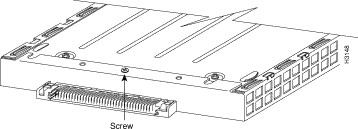
Step 6 Remove the screw that secures the port adapter (or blank port adapter).
Step 7 With the screw removed, grasp the handle on the front of the port adapter (or blank port adapter) and carefully pull it out of its slot, away from the edge connector at the rear of the slot. (See Figure 10.)
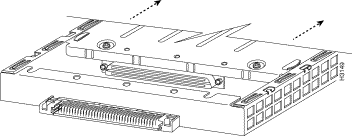
Step 8 If you removed a port adapter, place it in an antistatic container for safe storage or shipment back to the factory. If you removed a blank port adapter, no special handling is required; however, store the blank port adapter for potential future use.
Step 9 Remove the new port adapter from its antistatic container and position it at the opening of the slot. (See Figure 11.)
Step 10 Carefully align the leading edge of the port adapter carrier between the upper and lower slot edges, as shown in the cutaway in Figure 11. Do not jam the carrier between the slot edges.
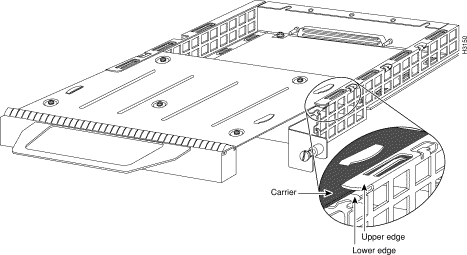
 | Caution To ensure a positive ground attachment between the port adapter carrier and the VIP2 motherboard and port adapter slot, and to ensure that the connectors at the rear of the port adapter and slot mate properly, the carrier must be between the upper and lower slot edges, as shown in Figure 12. |
Step 11 Carefully slide the new port adapter into the port adapter slot until the connector on the port adapter is completely mated with the connector on the motherboard. (See Figure 12.)
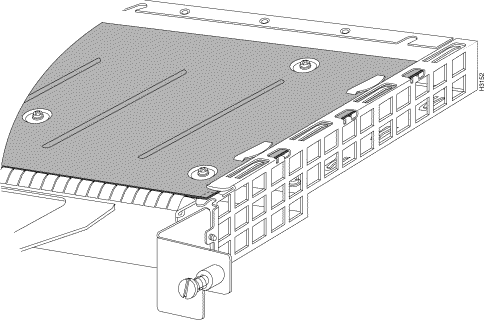
Step 12 Install the screw in the rear of the port adapter slot. (See Figure 9 for its location.) Do not overtighten this screw.
Step 13 Replace the VIP2 in the chassis. Follow the steps in the section "Installing a VIP2" in the configuration note Second-Generation Versatile Interface Processor (VIP2) Installation and Configuration (Document Number 78-2658-xx), which shipped with your VIP2.
Step 14 If disconnected, reconnect the interface cables to the port adapter.
This completes the procedure for installing a new port adapter or replacing a port adapter on a VIP2.
The 75-ohm coaxial cable (see Figure 13) required for the connections to PA-2JT2 are not available from Cisco Systems; they are available from commercial cable vendors. Use only 75-ohm coaxial cables for all PA-2JT2 connections. (For specific cable requirements, refer to the section "JT2 Port Adapter Interface Connectors and Cables" on page 9.)

Each E1-G.703/G.704 interface requires separate receive and transmit connections to an external B-type or C-type DSU. A DSU is available from outside vendors.
Use the following procedure to connect the 75-ohm coaxial cables to the JT2 port adapter:

Step 2 Referring to Figure 15, attach the network ends of your two 75-ohm coaxial cables to your external DSU as follows:
 | Caution To prevent system problems and to maintain the proper connection sequences (PA-2JT2's RX port to the DSU's TX port and PA-2JT2's TX port to the DSU's RX port), connect the RX and TX ports on the JT2 port adapter as indicated in Steps 1 and 2. |
Step 3 Make the appropriate setting on your DSU to establish an external ground. (See Figure 15.) Remember that the JT2 port adapter's TX and RX connections are grounded at the router-chassis side.
 | Caution To prevent system grounding and signal problems, your DSU must be set to accept an external ground because the JT2 port adapter's TX and RX connections are grounded at the router-chassis side. |
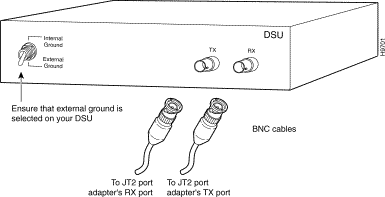
Step 4 Repeat Steps 1 through 3 for the additional JT2 interface as required.
This completes the procedure for attaching cables to the JT2 port adapter and an external B-type or C-type DSU.
After you verify that the new JT2 port adapter is installed correctly (the enabled LED goes on), use the privileged-level configure command to configure the new interfaces. Be prepared with the information you will need, such as the following:
For a summary of the configuration options available and additional instructions for configuring the JT2 interfaces on the JT2 port adapter, refer to the appropriate configuration publications listed in the section "If You Need More Information" on page 2.
The configure command requires privileged-level access to the EXEC command interpreter, which usually requires a password. Contact your system administrator if necessary to obtain EXEC-level access.
This section describes how to identify interface processor slot, port adapter slot, and interface port numbers.
In the router, physical port addresses specify the actual physical location of each interface port on the router interface processor end. (See Figure 16.) This address is composed of a three-part number in the format interface processor slot number/port adapter number/interface port number, as follows:
Interface ports on the JT2-equipped VIP2 maintain the same addresses regardless of whether other interface processors are installed or removed. However, when you move a VIP2 to a different slot, the first number in the address changes to reflect the new interface processor slot number.
Figure 16 shows the port adapter slots and interface ports of a sample Cisco 7505 system. The JT2 interface addresses on a JT2 port adapter in the first port adapter slot in interface processor slot 3, would be 3/0/0 and 3/0/1, from left to right. The JT2 interfaces on a JT2 port adapter in port adapter slot 1 would be numbered 3/1/0 and 3/1/1, from left to right.

You can identify interface ports by physically checking the slot/port-adapter/interface port location on the back of the router or by using show commands to display information about a specific interface or all interfaces in the router.
This section describes a basic configuration. At any time you can exit the privileged level and return to the user level by entering disable at the prompt as follows:
Router# disable
Router>
In the following basic configuration procedure, press the Return key after each step unless otherwise noted:
Router# configure terminal
Enter configuration commands, one per line. End with CNTL/Z.
Router(config)#
Step 2 At the prompt, specify the first interface to configure by entering the subcommand interface, followed by the type (serial) and slot/port-adapter/interface (interface processor slot number). The example that follows is for the first interface of the first port adapter on a JT2 port adapter in interface processor slot 1:
Router(config)# interface serial 1/0/0
Step 3 If IP routing is enabled on the system, you can assign an IP address and subnet mask to the interface with the ip address configuration subcommand, as in the following example:
Router(config-int)# ip address 1.1.1.10 255.255.255.0
Step 4 Add any additional configuration subcommands required to enable routing protocols and set the interface characteristics.
Step 5 Change the shutdown state to up and enable the interface as follows:
Router(config-int)# no shutdown
Step 6 Configure additional interfaces as required.
Step 7 When you have included all of the configuration subcommands to complete the configuration, press Ctrl-Z to exit configuration mode.
Step 8 Write the new configuration to nonvolatile memory as follows:
Router# copy running-config startup-config
[OK]
Router#
To check the interface configuration using show commands, proceed to the section "Checking the Configuration."
For data transmission at JT2 (6.312 Mbps), the G.704 standard suggests a 5-bit CRC. (Refer to ITU Recommendation G.704 for the definition of CRC5.)
To enable CRC5 on the JT2 interfaces, specify the slot and port address of the interface and the number of bits to use in the CRC (using crc 32), followed by the command crc bits 5. Press Ctrl-Z after altering the configuration and before exiting configuration mode.
The example that follows shows how to enable CRC5 generation on a JT2 interface and also how to set the CRC size to 32 bits; the example refers to JT2 interface 0 on the first JT2 port adapter on a VIP2 in interface processor slot 3:
Router# configure terminal
Enter configuration commands, one per line. End with CNTL/Z.
Router(config)# interface serial 3/0/0
Router(config-int)# crc 32
Router(config-int)# crc bits 5
Router(config-int)# ^Z
To disable CRC5 and return to the default of no CRC error checking, specify the slot and port address and use the no crc bits 5 command.
After configuring the new interface, use the show commands to display the status of the new interface or all interfaces, and use the ping command to check connectivity.
The following steps use show commands to verify that the new interfaces are configured and operating correctly.
Step 2 Display all the current interface processors and their interfaces with the show controllers cbus command. Verify that the new JT2 port adapter appears in the correct slot.
Step 3 Specify one of the new interfaces with the show interfaces type slot/port-adapter/interface command and verify that the first line of the display specifies the interface with the correct slot number. Also verify that the interface and line protocol are in the correct state: up or down.
Step 4 Display the protocols configured for the entire system and specific interfaces with the show protocols command. If necessary, return to configuration mode to add or remove protocol routing on the system or specific interfaces.
Step 5 Display the running configuration file with the show running-config command. Display the configuration stored in NVRAM using the show startup-config command. Verify that the configuration is accurate for the system and each interface.
If the interface is down and you configured it as up, or if the displays indicate that the hardware is not functioning properly, ensure that the network interface is properly connected and terminated. If you still have problems bringing the interface up, contact a service representative for assistance.
To display information about a specific interface, use the show interfaces command with the interface type and port address in the format show interfaces [type slot/port-adapter/port].
The following example shows all of the information specific to the first JT2 interface port (interface port 0) in interface processor slot 3, port adapter slot 0:
Router# sh int serial 3/0/0
Serial3/0/0 is up, line protocol is up
Hardware is cyBus Serial
Internet address is 1.0.0.1/8
MTU 1500 bytes, BW 6312 Kbit, DLY 20000 usec, rely 255/255, load 26/255
Encapsulation HDLC, loopback not set, keepalive not set
Last input 00:04:31, output 00:04:31, output hang never
Last clearing of "show interface" counters 00:06:07
Queueing strategy: fifo
Output queue 0/40, 0 drops; input queue 0/75, 0 drops
5 minute input rate 162000 bits/sec, 8 packets/sec
5 minute output rate 162000 bits/sec, 8 packets/sec
20005 packets input, 20080520 bytes, 0 no buffer
Received 0 broadcasts, 0 runts, 0 giants
0 input errors, 0 CRC, 0 frame, 0 overrun, 0 ignored, 0 abort
20005 packets output, 20080520 bytes, 0 underruns
0 output errors, 0 collisions, 0 interface resets
0 output buffer failures, 0 output buffers swapped out
0 carrier transitions
0 cv errors, 0 crc5 errors, 0 frame errors
rxLOS inactive, rxLOF inactive, rxPAIS inactive
rxAIS inactive, rxRAI inactive, rxHBER inactive
The following counters appear in the output of the show interfaces serial command:
The following alarm indicators also appear in the output of the show interfaces serial command:
For complete command descriptions and examples, refer to the publications listed in the section "If You Need More Information" on page 2.
Router# sh version
Cisco Internetwork Operating System Software
IOS (tm) GS Software (RSP-JV-M), Version 11.1(12)CA1 [biff 137]
Synced to mainline version: 11.1(8)
Copyright (c) 1986-1997 by cisco Systems, Inc.
Compiled Sat 10-May-97 19:19 by biff
Image text-base: 0x600108A0, data-base: 0x609DA000
ROM: System Bootstrap, Version 5.3(16645) [biff 571], INTERIM SOFTWARE
ROM: GS Software (RSP-BOOT-M), Experimental Version 11.1(618) [biff 114]
Router uptime is 16 hours, 2 minutes
System restarted by reload
System image file is "biff/rsp-jv-mz.g703", booted via tftp from 1.1.1.254
cisco RSP2 (R4600) processor with 16384K bytes of memory.
R4600 processor, Implementation 32, Revision 2.0
Last reset from power-on
G.703/E1 software, Version 1.0.
G.703/JT2 software, Version 1.0.
SuperLAT software copyright 1990 by Meridian Technology Corp).
Bridging software.
X.25 software, Version 2.0, NET2, BFE and GOSIP compliant.
TN3270 Emulation software (copyright 1994 by TGV Inc).
Chassis Interface.
1 VIP2 controllers (2 Serial).
2 Serial network interfaces.
125K bytes of non-volatile configuration memory.
16384K bytes of Flash PCMCIA card at slot 0 (Sector size 128K).
8192K bytes of Flash internal SIMM (Sector size 256K).
No slave installed in slot 7.
Configuration register is 0x2
The show controllers cbus command shows assorted information about the interfaces installed in the router. Following is an example of partial output from the show controllers cbus command, showing a JT2-equipped VIP2:
Router# sh cont cbus
MEMD at 40000000, 2097152 bytes (unused 4352, recarves 18, lost 0)
RawQ 48000100, ReturnQ 48000108, EventQ 48000110
BufhdrQ 48000130 (2643 items), LovltrQ 48000148 (16 items, 2016 bytes)
IpcbufQ 48000158 (24 items, 4096 bytes)
IpcbufQ_classic 48000150 (8 items, 4096 bytes)
3570 buffer headers (48002000 - 4800FF10)
pool0: 10 buffers, 256 bytes, queue 48000138
pool1: 720 buffers, 1536 bytes, queue 48000140
pool2: 145 buffers, 4512 bytes, queue 48000160
pool3: 4 buffers, 4544 bytes, queue 48000168
slot9: VIP2, hw 2.3, sw 21.40, ccb 5800FFA0, cmdq 480000C0, vps 8192
software loaded from flash slot0:vip2_21-40
IOS (tm) VIP2 Software (SVIP-DW-M), Version 11.1(12)CA1 [biff 162]
ROM Monitor version 17.0
Mx JT2 Serial(2), HW Revision 0x2, FW Revision 1.26
Serial5/0/0, applique is JT2 Unbalanced
received clockrate 6155735
gfreeq 48000140, lfreeq 48000278 (1536 bytes), throttled 0
rxlo 4, rxhi 60, rxcurr 0, maxrxcurr 1
txq 48001A80, txacc 48001A82 (value 39), txlimit 39
To determine which type of port adapter is installed on a VIP2 in your system, use the show diag slot command. Specific port adapter information is displayed, as shown in the following example of an JT2 port adapter in a VIP2 in interface processor slot 9:
Router# sh diag 9
Slot 9:
Physical slot 9, ~physical slot 0x6, logical slot 9, CBus 0
Microcode Status 0x4
Master Enable, LED, WCS Loaded
Board is analyzed
Pending I/O Status: None
EEPROM format version 1
VIP2 controller, HW rev 2.3, board revision A0
Serial number: 03515977 Part number: 73-1684-03
Test history: 0x00 RMA number: 00-00-00
Flags: cisco 7000 board; 7500 compatible
EEPROM contents (hex):
0x20: 01 15 02 03 00 35 A6 49 49 06 94 03 00 00 00 00
0x30: 50 00 00 00 00 00 00 00 00 00 00 00 00 00 00 00
Slot database information:
Flags: 0x4 Insertion time: 0x3C58 (16:06:46 ago)
Controller Memory Size: 16 MBytes DRAM, 1024 KBytes SRAM
PA Bay 0 Information:
JT2 Serial PA, 2 ports
EEPROM format version 1
HW rev 1.FF, Board revision UNKNOWN
Serial number: 4294967295 Part number: 255-65535-255
The show startup-config command displays the information from the configuration file used at system startup. Following is an example of partial output from the show startup-config command from a system with a JT2 port adapter installed and configured:
Router# sh startup-conf
(additional display text omitted)
hostname Router
!
interface Serial9/0/0
ip address 28.0.0.1 255.0.0.0
ip route-cache distributed
no keepalive
crc5
clock source internal
no cdp enable
!
The JT2 port adapter is capable of clocking transmitted data using an internal clock source or a clock derived from the received data stream. The default is a line-derived clock source; however, each JT2 interface will use its internal clock if no external clock is detected.
The clock source internal command sets the clock source as indicated. The no clock source command restores the system default.
By default, the system uses no CRC5. The crc bits 5 interface command allows the frame alignment search criteria to use CRC5. The no crc bits 5 interface command allows CRC5 to be excluded from the frame alignment search criteria.
The packet internet groper (ping) command allows you to verify that an interface port is functioning properly and to check the path between a specific port and connected devices at various locations on the network. This section provides brief descriptions of the ping command. After you verify that the system and JT2-equipped VIP2 have booted successfully and are operational, you can use this command to verify the status of interface ports. Refer to the publications listed in the section "If You Need More Information" on page 2, for detailed command descriptions and examples.
The ping command sends an echo request out to a remote device at an IP address that you specify. After sending a series of signals, the command waits a specified time for the remote device to echo the signals. Each returned signal is displayed as an exclamation point (!) on the console terminal; each signal that is not returned before the specified time-out is displayed as a period (.). A series of exclamation points (!!!!!) indicates a good connection; a series of periods (.....) or the messages [timed out] or [failed] indicate that the connection failed.
Following is an example of a successful ping command to a remote server with the address 1.1.1.10:
Router# ping 1.1.1.10 <Return>
Type escape sequence to abort.
Sending 5, 100-byte ICMP Echoes to 1.1.1.10, timeout is 2 seconds:
!!!!!
Success rate is 100 percent (5/5), round-trip min/avg/max = 1/15/64 ms
Router#
If the connection fails, verify that you have the correct IP address for the server and that the server is active (powered on); then repeat the ping command.
For additional descriptions of interface subcommands and the configuration options available for JT2-related interfaces, refer to the publications listed in the section "If You Need More Information" on page 2.
Cisco Connection Online (CCO) is Cisco Systems' primary, real-time support channel. Maintenance customers and partners can self-register on CCO to obtain additional information and services.
Available 24 hours a day, 7 days a week, CCO provides a wealth of standard and value-added services to Cisco's customers and business partners. CCO services include product information, product documentation, software updates, release notes, technical tips, the Bug Navigator, configuration notes, brochures, descriptions of service offerings, and download access to public and authorized files.
CCO serves a wide variety of users through two interfaces that are updated and enhanced simultaneously: a character-based version and a multimedia version that resides on the World Wide Web (WWW). The character-based CCO supports Zmodem, Kermit, Xmodem, FTP, and Internet e-mail, and it is excellent for quick access to information over lower bandwidths. The WWW version of CCO provides richly formatted documents with photographs, figures, graphics, and video, as well as hyperlinks to related information.
You can access CCO in the following ways:
For a copy of CCO's Frequently Asked Questions (FAQ), contact cco-help@cisco.com. For additional information, contact cco-team@cisco.com.

![]()
![]()
![]()
![]()
![]()
![]()
![]()
![]()
Posted: Wed Apr 25 14:02:44 PDT 2001
All contents are Copyright © 1992--2001 Cisco Systems, Inc. All rights reserved.
Important Notices and Privacy Statement.